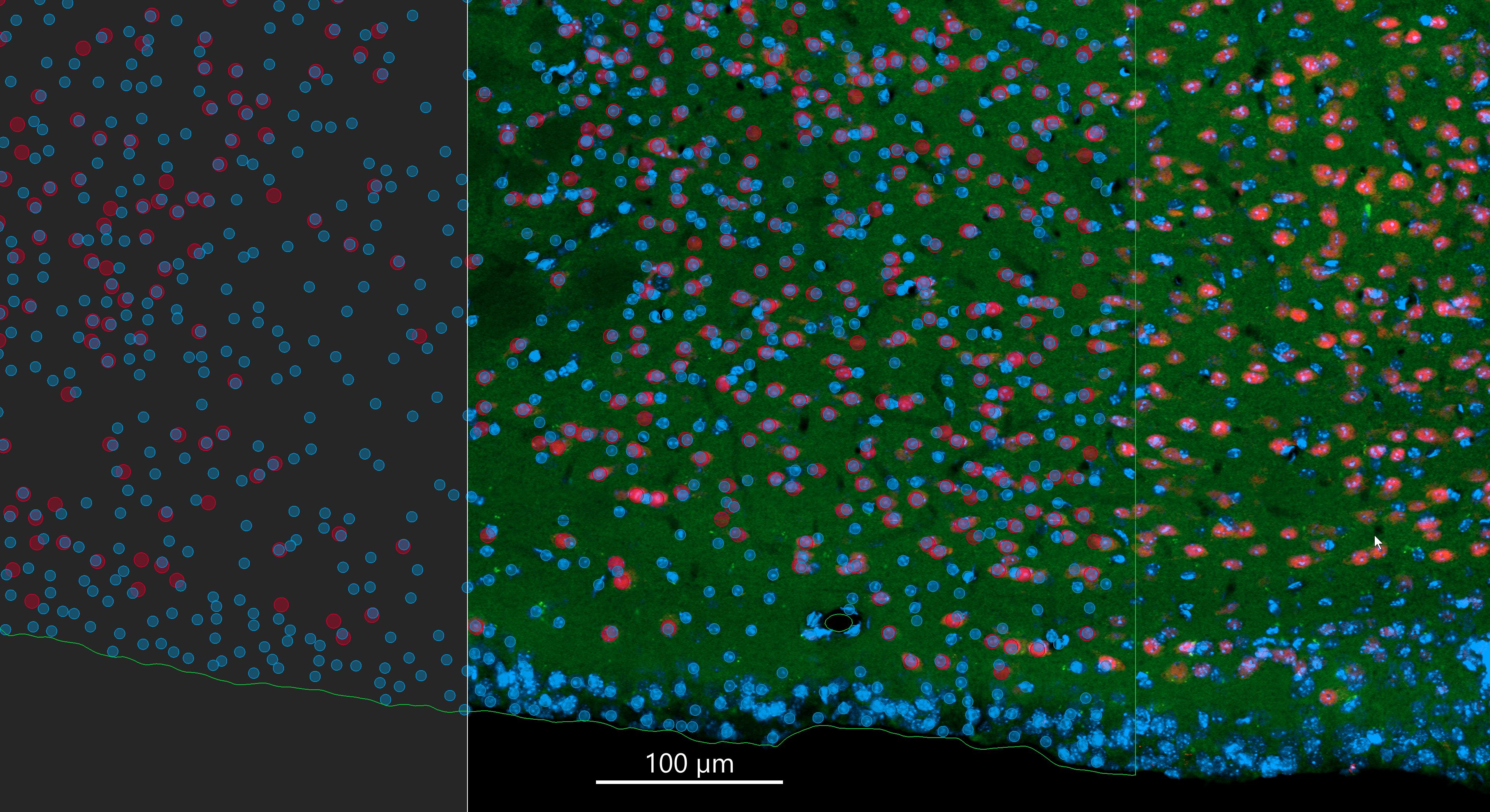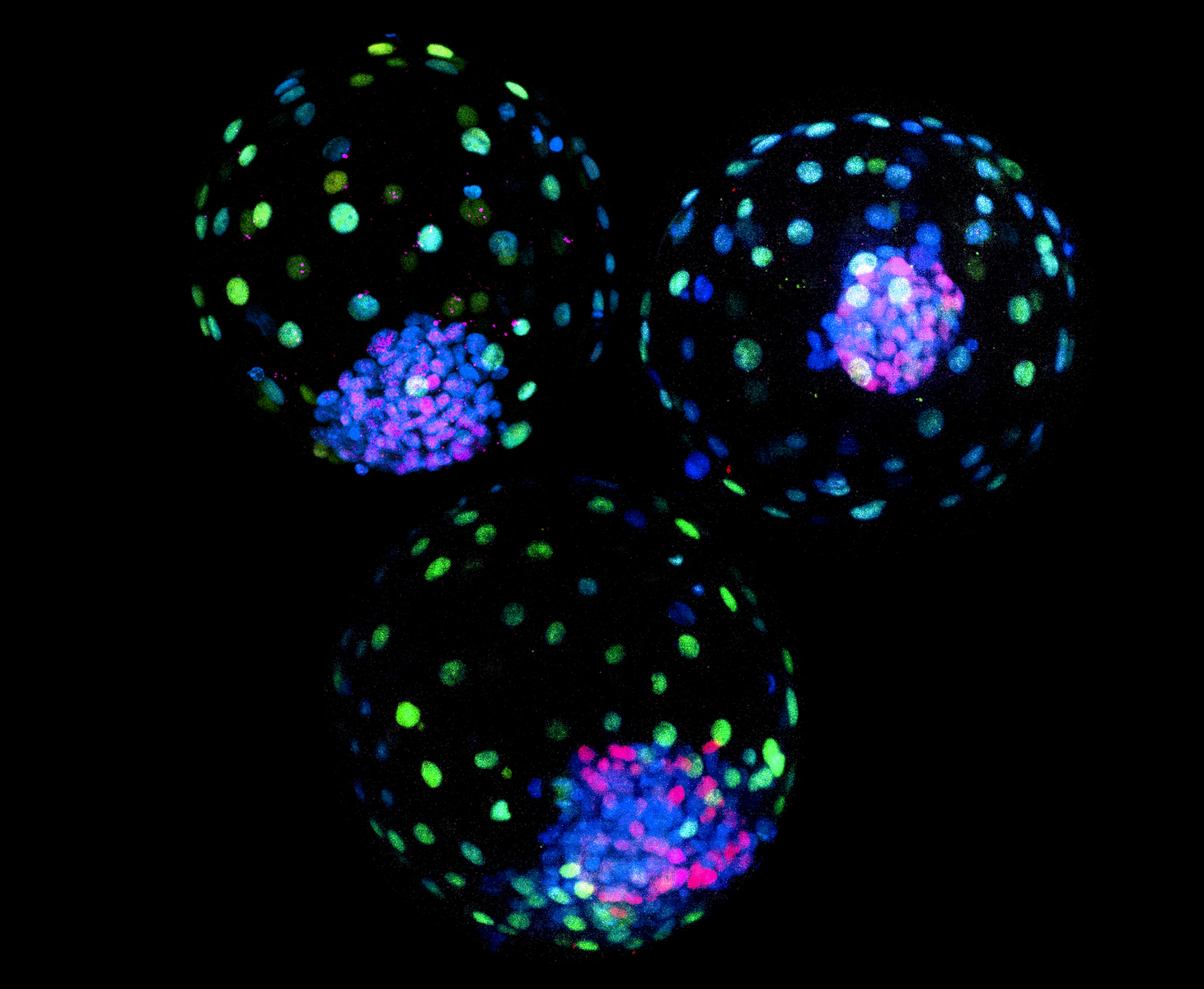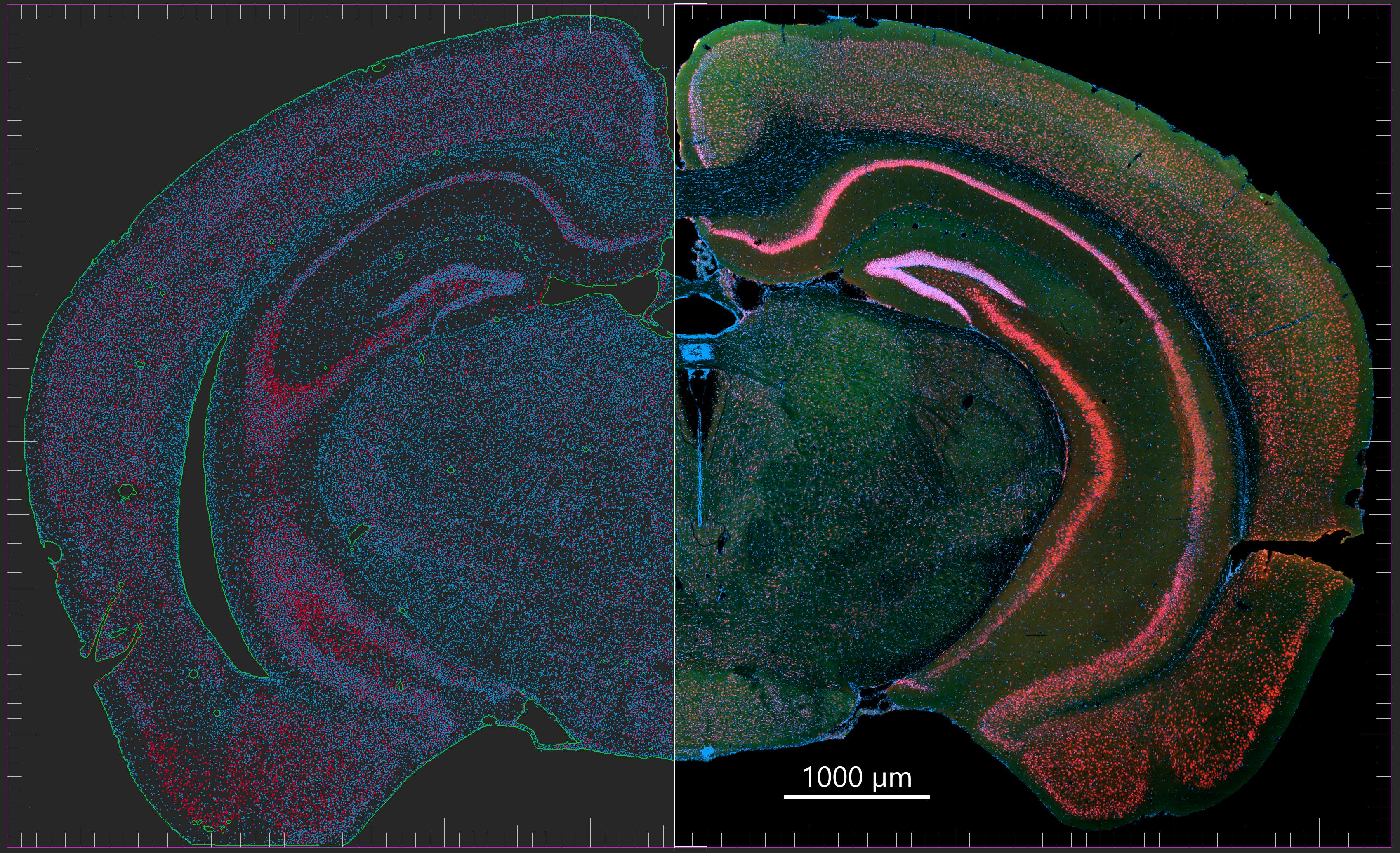Photo Gallery
Click image to view full version -

Rendering of frontal mouse brain section
Mouse brain; frontal sectioning. 3-color dataset was acquired on Zeiss LSM980 with AiryScan2 and AI sample finder; Objective: Plan-Apochromat 25x/0.8 oil immersion. Top: Overview. Right side: raw data, Middle: raw data + overlay; Left: overlay - Imaris spot detection for red/blue channels and surface detection for green channel. Bottom: zoom-in. Image properties: 735 stitched tiles; pixel size: 0.124 x 0.124 µm; image dimensions: 76,822px x 46,842 px; total # of pixels: 3,598,496,124; scan time: ~40 minutes with AiryScan2 in fast confocal 8Y; file size: ~ 27Gb. Image rendering Imaris 10.2.0. Credit: Chad Smith, Monson lab .
Mouse brain; frontal sectioning. 3-color dataset was acquired on Zeiss LSM980 with AiryScan2 and AI sample finder; Objective: Plan-Apochromat 25x/0.8 oil immersion. Top: Overview. Right side: raw data, Middle: raw data + overlay; Left: overlay - Imaris spot detection for red/blue channels and surface detection for green channel. Bottom: zoom-in. Image properties: 735 stitched tiles; pixel size: 0.124 x 0.124 µm; image dimensions: 76,822px x 46,842 px; total # of pixels: 3,598,496,124; scan time: ~40 minutes with AiryScan2 in fast confocal 8Y; file size: ~ 27Gb. Image rendering Imaris 10.2.0. Credit: Chad Smith, Monson lab .

U2OS expressing lifeact
Live U2OS cells expressing mNeonGreen-Lifeact labeled F-actin. Comparison of TIR-FM and TIR-FM with SIM (structured illumination). GE OMX SR, TIRF and TIRF-SIM; 60x/1.42NA; Credit: Runwen Yao.
Live U2OS cells expressing mNeonGreen-Lifeact labeled F-actin. Comparison of TIR-FM and TIR-FM with SIM (structured illumination). GE OMX SR, TIRF and TIRF-SIM; 60x/1.42NA; Credit: Runwen Yao.

Mouse kidney - Overview
Mouse kidney section with WGA-Alexa488, Phalloidin-Alexa561 and DAPI, Zeiss LSM980 Airyscan2; Plan-Apochromat 20x/0.8NA; 342 stitched tiles - strongly downscaled resolution Credit Marcel Mettlen.
Mouse kidney section with WGA-Alexa488, Phalloidin-Alexa561 and DAPI, Zeiss LSM980 Airyscan2; Plan-Apochromat 20x/0.8NA; 342 stitched tiles - strongly downscaled resolution Credit Marcel Mettlen.

Murine Femur Section
Femur of a young adult mouse injected with EdU. Frozen bone section was stained with a Click-it EdU 488 imaging kit and anti-Aggrecan antibody (visualized with CF555). Section was mounted with ProLong Gold antifade in DAPI buffer and imaged on a Nikon CSU-W1 spinning disk confocal. Cropped and down-sampled view from a larger 15x5 stitched image. Objective: 20x/0.75NA. Credit Jingzhu Zhang
Femur of a young adult mouse injected with EdU. Frozen bone section was stained with a Click-it EdU 488 imaging kit and anti-Aggrecan antibody (visualized with CF555). Section was mounted with ProLong Gold antifade in DAPI buffer and imaged on a Nikon CSU-W1 spinning disk confocal. Cropped and down-sampled view from a larger 15x5 stitched image. Objective: 20x/0.75NA. Credit Jingzhu Zhang

Photoconversion of PSmOrange
U2OS were transfected with DNA coding for H2B-PSmOrange. Cells were then imaged using a Nikon CSU-W1 with FRAP module. PSmOrange was converted by 488nm light from red to far-red (using a binarized Mona Lisa as ROI). Objective: 100x; 1.45NA; Credits: Marcel Mettlen (imaging) and Etai Sapoznik (Fiolka lab, UTSW) for kindly providing these cells.
U2OS were transfected with DNA coding for H2B-PSmOrange. Cells were then imaged using a Nikon CSU-W1 with FRAP module. PSmOrange was converted by 488nm light from red to far-red (using a binarized Mona Lisa as ROI). Objective: 100x; 1.45NA; Credits: Marcel Mettlen (imaging) and Etai Sapoznik (Fiolka lab, UTSW) for kindly providing these cells.

Object-based colocalization
Object-based colocalization with Imaris; ARPE cells expressing eGFP-clathrin light chain, mRuby3-AP2 and stained with Dapi and phalloidin-Alexa647. Single wide-field image was used for projection and detection of objects. Blue: volume-rendered nucleus and clathrin structures within a distance of 2 µm. Small gray spheres: non-colocalizing clathrin spots. Red/green: clathrin colocalizing with AP2. Credit: Marcel Mettlen
Object-based colocalization with Imaris; ARPE cells expressing eGFP-clathrin light chain, mRuby3-AP2 and stained with Dapi and phalloidin-Alexa647. Single wide-field image was used for projection and detection of objects. Blue: volume-rendered nucleus and clathrin structures within a distance of 2 µm. Small gray spheres: non-colocalizing clathrin spots. Red/green: clathrin colocalizing with AP2. Credit: Marcel Mettlen

Blastoid
Bovine blastoids assembled by trophoblast stem cells and expanded potential stem cells. Stained for epiblast marker SOX2, hypoblast marker SOX17 and trophectoderm marker (CDX2). Acquired on a Nikon CSU-W1 spinning-disk super resolution by optical pixel reassignment (SoRa) confocal microscope. 60x/1.4NA; Credit Carlos A. Pinzón Arteaga
Bovine blastoids assembled by trophoblast stem cells and expanded potential stem cells. Stained for epiblast marker SOX2, hypoblast marker SOX17 and trophectoderm marker (CDX2). Acquired on a Nikon CSU-W1 spinning-disk super resolution by optical pixel reassignment (SoRa) confocal microscope. 60x/1.4NA; Credit Carlos A. Pinzón Arteaga

DNA paint
These images showcase super-resolution imaging via DNA origami of various patterns. Comparison between TIR-FM and DNA-PAINT imaging techniques using the GE OMX SR microscope. 60x/1.49NA TIRF objective. Credit: Runwen Yao.
These images showcase super-resolution imaging via DNA origami of various patterns. Comparison between TIR-FM and DNA-PAINT imaging techniques using the GE OMX SR microscope. 60x/1.49NA TIRF objective. Credit: Runwen Yao.





